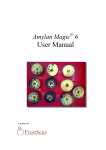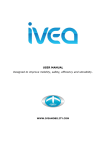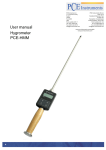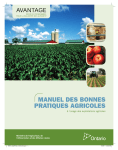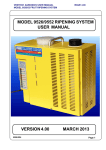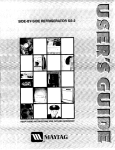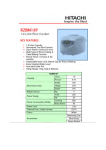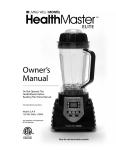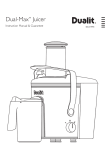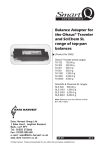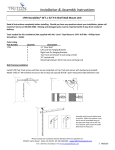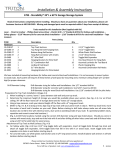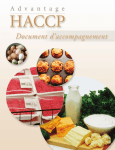Download Amylan Magic
Transcript
Amylan Magic 8 User Manual A product by In collaboration with Amylan Magic© 8 User Manual Table of Contents Introduction ...................................................................................................................... 3 Preparing a fruit sample for analysis ............................................................................... 5 Positioning the fruit.......................................................................................................... 6 Selecting a conversion program ....................................................................................... 8 Capturing the Video Feed .............................................................................................. 12 Obtaining, Correcting and Saving Starch-Iodine Results .............................................. 14 Obtaining results .................................................................................................... 14 Correcting results ................................................................................................... 17 Assessing detection quality .................................................................................... 17 Sample Identification ..................................................................................................... 19 Additional observations ................................................................................................. 20 Firmness Input ............................................................................................................... 20 Recording Internal Disorders ......................................................................................... 20 History............................................................................................................................ 22 Appendix: The iodine-starch method: introduction and methodology .......................... 23 Summary: Program flow logic ....................................................................................... 26 2 Amylan Magic© 8 User Manual Introduction Amylan Magic is a combined system for assessing apple and pear fruit maturation using the starch-iodine test. The procedure of assessing the fruit comprises five simple steps: A fruit sample, pre-treated with iodine solution, is loaded onto a red tray and inserted into an illuminated chamber. The sample is photographed and the image is transferred onto a computer desktop. A robust image-analysis procedure, distinguishing reactive areas of the fruit sections from non-reactive ones and fruit area from the background, then assesses the image. The calculated starch index is displayed for each individual fruit and may be corrected by the user. The results are saved to database. An effort has been made to keep the Amylan Magic system user friendly and its operation straightforward. Amylan Magic supports fruit samples containing up to 12 fruits. The Amylan Magic system’s results are assured to deviate within ±0.5 starch-index unit (assuming a 10-fruit sample at 1-10 starch index range) from the results obtained by an experienced technician. Non-experienced personnel can easily operate the Amylan Magic system as the determination of the starch index is digitally controlled. Amylan Magic enables you to save firmness and internal disorder data. New and old data may be displayed for supporting decisions on the fruit storage strategy. Images may be saved to disk for reference. 3 Amylan Magic© 8 User Manual 4 Amylan Magic© 8 User Manual Preparing a fruit sample for analysis Prepare the samples for analysis in the same method you would usually employ for starch index determination: 1. Cut the fruit across its equator, through the center of its core. 2. Apply I/KI solution to the exposed flesh of the bottom half of the fruit. 3. Wait for the iodine solution to fully interact with the starch in the exposed tissue. Instead of comparing the staining patterns to a pictorial reference chart and calculating the sample statistics, follow these steps: 1. Arrange the fruit on the included red tray with the treated surface facing upward. 2. Insert the tray into the light chamber. 3. Block the opening at the front of the light chamber to eliminate stray light. 4. Run Amylan Magic. The required waiting time between applying the solution and sample analysis varies with temperature and the freshness of the solution. Using Amylan Magic, the waiting time may be reduced by about 50%. 5 Amylan Magic© 8 User Manual Positioning the fruit The Amylan Magic system is designed to test samples comprising up to 12 fruits. The framework of fruit positioning is the area of the red tray. You must leave spaces between individual fruit so that each fruit is detected independently. It is also required that you leave margins of at least 1 cm from the edges of the tray. The Amylan Magic system scans the tray area looking for oval, non-red shapes and analyzes each fruit separately to calculate its starch index. Fruit may vary in size, but should be in the diameter range between 40-100 mm. 6 Amylan Magic© 8 User Manual Be sure to wipe the red tray off any remaining iodine stains and droplets before positioning a new sample. correct incorrect incorrect Fruit positioning: configuration. 7 Amylan Magic© 8 User Manual Selecting a conversion program In order to convert the ratio of reactive area of a fruit to an intelligible starch index value, a conversion function must be applied. The shape of the conversion function is controlled by a single parameter, which is the steepness of the curve. It affects the local ratio at which the starch index increases in response to a linear decline in the ratio of reactive area. The commonly-used starch index systems are near-linear functions of the perceived stained ratio rather than of the mathematical one. This parameter can be manipulated in a protected area of the 'Settings' tab termed 'Advanced settings'. To open it, click the title of the box and enter the password: 8080. Possible values of the 'Perception coefficient' bar range between 0 and 100. It is strongly recommended to keep this parameter around 50, a value that represents the visual interpretation of most humans. The effect of the perception coefficient is illustrated in the following diagram: 8 Amylan Magic© 8 User Manual Changing the coefficient will have the greatest effect on the calculated starch index in the middle to upper part of the scale. Amylan Magic can use two options: 1. A user-defined polynomial function up to the 4th order, adjusted for species and variety. 2. A generalized function which translates the ratio of reactive area to typical human impression and then assigns it to a user-defined starch index scale. Conversion programs Amylan Magic comes ready with four pre-defined conversion programs for apple, complying with the 1-5, 1-6, 1-8 and 1-10 standard systems, respectively. Those programs are invariably suited to radial-type and central-type apple varieties. To select a program, check the Use conversion program option in the 'Settings' tab and then select a program in the table below by clicking on the left margin of the appropriate row. Make sure that the selected program appears in the 'Conversion program' box inside the 'Starch analysis' tab. Modifying and adding conversion programs Amylan Magic supports polynomial equations of up to 4th power in the general form: a x 4 b x3 c x 2 d x e where x is the visual representation of the reactive area ratio. 9 Amylan Magic© 8 User Manual To create a new conversion program, carefully follow these instructions: 1. Create a new program by typing its attributes into the 'Programs' table in the 'Settings' tab: Give it a distinguishable name (e.g. "Test no 1"), set the correct minimum and maximum starch indices and type arbitrary numeric values (e.g. 10) in the P4-P0 fields. Select this program by clicking on the left margin of the appropriate row in the table. 2. Insert a sample of fruit and let the program analyze it. The starch indices calculated will obviously be all wrong. 3. Carefully correct the reading of each individual fruit so it perfectly matches your selected pictorial reference. 4. Click the Resume video button. 5. Repeat steps 2 and 3 until the entire test sample is analyzed and corrected. The larger the samples the more efficient the resulting conversion function. 6. Open the Excel workbook Conversion parameters.xls located in the 'Amylan Magic' folder. The data will refresh automatically and include the test sample. 7. Select the name of the test program in the 'Program' column (column C) and click the yellow box. 8. Copy each parameter to its corresponding position in the list of programs in the 'Settings' tab. Observe the graph portraying the new conversion program and the R2 value. Numbers greater than 0.99 indicates a strong conversion program. 10 Amylan Magic© 8 User Manual Simplified conversion To use the generalized conversion, check the Use simplified conversion option in the 'Settings' tab and then set the minimum and maximum values of your favorite starch index scale in the 'Conversion program' box inside the 'Starch analysis' tab. The generalized conversion uses a pre-set 4th-order polynomial function. It is strongly recommended not to change its parameters. The simplified function might be slightly less precise than specific conversion programs, but it should work well enough in most situations. 11 Amylan Magic© 8 User Manual Capturing the Video Feed Slide a fruit sample properly positioned on a red tray into the illuminated chamber. Allow the sample to rest for approximately 3 seconds until the video feed stabilizes. Click the Capture Image button at the top right corner of the 'Starch analysis' tab. The first step in the analysis is to separate the fruit from the red background. Precise separation is crucial for the accuracy of the analysis. The quality of background separation can be monitored by double clicking the captured image. This will restore the view to the un-processed original. Double clicking it again will restore the separated version. There are three parameters which control the separation: 1. Minimum background saturation – specifies the minimum chroma of the background. Recommended values are 50-60. 2. Minimum background hue – specifies the lower threshold of hue for the separation. Recommended values are 190-210. 12 Amylan Magic© 8 User Manual 3. Maximum background hue – specifies the upper threshold of hue for the separation. Recommended values are 25-35. Setting these parameters is done by clicking the corresponding '+' and '-' buttons in the 'Fruit isolation' box of the 'Starch analysis' tab. In general, clicking '+' will increase the area of the fruit while clicking '-' will increase the area of the background. Clicking these buttons will cause the background to be re-separated and the captured view to refresh. Maximum hue has the most significant effect on fruit isolation. The actual values of those three parameters can be viewed and set in the 'Fruit isolation parameters' box in the 'Settings' tab. Checking the 'Eliminate penetrometer cavities' option will cause the program to attempt elimination of the dark cavities at the periphery of the fruit. Seeds are usually also subtracted from the fruit due to their brown hue, which is similar to the background. Checking the 'Eliminate core cavity' box will make sure non-pulp tissue is subtracted. 13 Amylan Magic© 8 User Manual Obtaining, Correcting and Saving Starch-Iodine Results Obtaining results After capturing a sample, click the Analyze sample button. The software will scan the image and analyze the detected fruits individually. This process is quite complex and might require a few seconds. During the scan the image is "cleaned" off objects which do not satisfy the following criteria: 1. An oval shape. 2. Diameter larger than approximately 40mm. 3. Diameter smaller than approximately 100mm. Subsequently, adjacent fruit will be eliminated from the analysis. Fruits which were poorly separated from the background during capturing are also likely to be omitted at this stage. Amylan Magic uses an internal detection algorithm that does not depend on external references to separate reactive pulp sections from non-reactive ones. It is characterized by fairly low sensitivities to variation in lighting and to blur caused by inaccurate focusing of the optics. The detection algorithm has one user-defined parameter, which is whether it should consider colour information or be restricted to luminosity. It is possible to change this parameter in the 'Consider colour information' option which is positioned inside a protected area of the 'Settings' tab termed 'Advanced settings'. To open it, click the title of the box and enter the password: 8080. Using colour information will usually obtain somewhat higher starch index values. 14 Amylan Magic© 8 User Manual The results of the analysis are displayed in a variety of ways: 1. The 'Sample results' box, which encompasses the statistics of the sample. It includes four labels: a) Mean – the average starch index of the sample. b) Error interval – the confidence interval of the average (=0.1). c) Standard deviation – the standard deviation of the sample’s starch indices. d) Sample size – the number of individual fruits analyzed. 2. The borders of reactive pulp areas are emphasized in red if the 'Borders' option is checked in the 'Display options' box on the 'Starch analysis' tab. 3. Starch indices of individual fruit are displayed inside the image area if the 'Individual results' option is checked in the 'Display options' box on the 'Starch analysis' tab. 15 Amylan Magic© 8 User Manual 4. A box indicating the range between -1 and +1 standard deviations (in red) and the sample mean (in blue) appears in the reference chart on the right side of the software window. This provides a visual way to assess the quality of the analysis and emphasizes the sample's variability. Most of the fruits in the sample must resemble images inside the red box to consider the automatic analysis satisfactory. Since the distribution of small samples is rarely Gaussian, outliers are likely. Obviously, the greater the variability the taller the box. For convenience, the reference chart includes a colour-coded scale which reflects the storage recommendations for most apple varieties and complies with 1-MCP application practice. 16 Amylan Magic© 8 User Manual Correcting results It is possible to correct an individual reading by clicking the label displaying its calculated starch index and changing it. Pressing [Enter] will update the data with the new value and the next fruit will be thus selected. Changing an individual reading will have an immediate effect on all sample statistics. Corrections are saved to database for further viewing and analysis. Assessing detection quality The detection of pulp areas containing starch depends on the staining response of the iodine-treated tissue. While the algorithms utilized by Amylan Magic are optimized specifically for this test, they may suffer some uncertainty in transition zones between reactive and non-reactive areas. This uncertainty may be particularly prominent in varieties with a central-type response such as Red Delicious and Granny Smith. Uncertainty level can be assessed by examining the borders between reactive and nonreactive areas in the analyzed image. It is also reflected in the error interval of the average starch index. high certainty low certainty 17 Amylan Magic© 8 User Manual If the error interval is consistently greater than 5% of the maximum starch value in the scale used, take the following measures: 1. Replace the iodine solution with a freshly-prepared one. 2. Increase the waiting time between iodine treatment and analysis. 3. Check the optical system inside the light chamber. If necessary, adjust the focal distance of the lens. Saving records Make sure that all the sample details have been entered in their appropriate destinations, including identification details and relevant additional observations. Make sure that the values in the ‘Sample results’ box are satisfactory. Then click the Save sample results button in the 'Sample results' box. Upon saving, video feed will be resumed and the program will be reset for testing a new sample. Data is saved to the ‘Amylan8.accdb’ database located in the ‘Amylan Magic’ directory. Checking the 'Print report' option in the 'Sample details' box will cause an image of the window to be sent to the default printer. If no printer is connected to the system an XML file will be created. Similarly, checking the 'Save report image' option will cause an image (such as the one below) of the results to be saved in the 'Result Images' subdirectory of the 'Amylan Magic' library. 18 Amylan Magic© 8 User Manual Sample Identification Fruit samples tested using the Amylan Magic system may be identified either by their source or by their bin barcode. All details entered in the ‘Sample details’ box may be either numeric or alphanumeric. It is recommended that you utilize the same coding method that is used in your organization. 19 Amylan Magic© 8 User Manual Additional observations Firmness Input Fruit firmness measurements are entered into the ‘Firmness' box in the 'Additional observations' tab. It is possible to enter the data in two different ways: 1. Type the result of each individual measurement in the corresponding text box. Pressing Enter after typing a value will update the sample average and standard deviation, and clear the text box for the next value. The number of firmness inputs per sample is unlimited. 2. Type the average firmness of the sample and its standard deviation directly into the respective text boxes. Firmness statistics, i.e. average and standard deviation, are recorded with the starch index statistics. Individual firmness values will be lost. It is also possible to store soluble solids and acidity data. Although firmness input is optional, it is strongly recommended that you do not rely solely on starch-iodine tests for evaluating fruit ripeness. Recording Internal Disorders Since the starch-iodine test involves slicing the fruit, internal disorders may be detected. The Amylan Magic system enables you to record them in the 'Internal disorders' box in the 'Additional observations' tab. Enter fruit counts by adjusting the up-down arrows for each disorder. Do not test infected fruit for starch content, as this 20 Amylan Magic© 8 User Manual will decrease the reliability of the test. The internally damaged fruit are recorded in the following way: D% D C T where D% is the specific disorder percent of the entire sample, D is the number of fruit displaying the specific disorder (typed by user), C is the tested fruit number and T is the total number of fruit displaying internal disorders. 21 Amylan Magic© 8 User Manual History Maturity, internal disorder and correction data can be loaded and viewed in Microsoft Excel worksheets. This is done by clicking the corresponding buttons in the 'History' tab. A concise view of recent measurements made to samples of the current grower and variety is available in the 'Maturity data' table on the 'History' tab. 22 Amylan Magic© 8 User Manual Appendix: The iodine-starch method: introduction and methodology The following section is based on 'Evaluating Maturity of McIntosh and Red Delicious Apples', a publication of the Ontario Ministry of Agriculture and Food (OMAF) written by C.L. George Chu - University of Guelph and Ken Wilson - Apple Specialist/OMAF Introduction As apple and pear fruit mature and ripen, the starch in the immature fruit is depolimerized to soluble sugars. Dipping a portion of the apple into an iodine solution can monitor the decreasing level of starch. The starch reacts with the iodine solution to produce a blue-black colour in a pattern characteristic for that cultivar. Where there is no reaction and no colour change, sugar has developed. Colour intensity and pattern can be compared to a pictorial chart to estimate fruit maturity. Pictorial charts have been developed for several apple varieties. When used along with other estimators, the Starch-Iodine Test can provide a good assessment of fruit maturity. Working with pictorial charts requires some expertise and often obtains varying results among different testers. The Amylan Magic system, utilizing digital image analysis methods, makes it possible for multiple, inexperienced users to run the tests. Iodine Solution WARNING: Iodine is a poisonous chemical. The iodine solution should be correctly labeled and kept away from children and pets. Consider treated apples poisonous and do not feed to any animal or use in composting. Do not allow pets to lick the fruit after testing. Ingestion of iodine or iodine-treated apples should be followed quickly by induced vomiting and consultation with a physician. Always make up a fresh solution at the beginning of the harvest season. Keep this solution in a dark coloured (or foil-wrapped) bottle and away from light. A pharmacist or anyone with a sensitive weighting device can use these directions to make up the iodine solution. 23 Amylan Magic© 8 User Manual Preparation of the iodine solution Dissolve 10 grams of potassium iodide in approximately 30 ml of warm water. Gently stir the solution until the potassium iodide is properly dissolved. When it is properly dissolved, add 5 grams of iodine crystals. Shake the mixture vigorously until the crystals are completely dissolved. Dilute this mixture with water to make 1.0 litres of test solution. Shake again. Sampling Begin sampling and testing 2 weeks before the anticipated harvest date. Randomly collect apples from different areas on several trees of the same cultivar. A sample of 10 apples is acceptable for each test. Testing the Fruit Sample Do not attempt to test apples if the iodine solution has not been recently prepared. The apples must be recently harvested. If the temperature of the apples, or of the iodine solution, is less than 10°C (50°F), inaccurate readings are likely to result. Pour the iodine solution into a shallow glass container to a depth of 5 - 8 mm. Cut each apple in half across the core and immerse the exposed surface of the bottom half in the iodine solution. Repeat with the next apple until at least 10 apples have been treated. In two to three days, repeat this test with another sample of freshly picked apples until you determine the correct harvest maturity for the intended market. Fruit may also be sampled and tested at harvest day in order to predict their storability and plan their cold storage strategy. Evaluating the results Generally, apples are suitable for regular CA storage as long as they have a rating of 4 to 7 starch-index units (when using a 1-10 scale). However, the more mature apples should be held for a shorter storage period. Fruit with a rating greater than 7 will have more flavour and a softer texture and be better suited for immediate consumer use. 24 Amylan Magic© 8 User Manual Such fruit may be successfully stored for a short period of time, but should be marketed while their superior eating qualities are still present. Always consult your experience and local recommendations for correctly interpreting the results obtained using Amylan Magic. 25 Amylan Magic© 8 User Manual Summary: program flow logic Order 1 Step description Preparation of the sample Machine - 2 3 Positioning Video streaming 4 Capturing of the image Detection of reactive pulp Matching mathematical reactive ratio to perceived ratio Conversion of perceived reactive ratio to starch index Setting camera parameters Recognition and isolation of fruits Finding the best cutoff point Computing the perceived ratio 5 6 7 8 Sample statistics 9 Additional information 10 Saving records 26 Computation of starch index, pre-defined conversion programs Computation of average and standard deviation - Data management User Iodine concentration, waiting time, solution freshness Laying the fruits correctly Focusing of the optics (if required) Manipulation of separation parameters (if required) Manipulation of perception coefficient (not recommended) Manipulation of conversion programs (if required), corrections (if required) Entering sample details, maturity indices and internal disorders - Amylan Magic© 8 User Manual System Requirements 1.8 GHz processor or higher. Windows XP/Vista/7/8. 2 GB RAM memory or higher. VGA screen card with 8 MB memory or higher. 150 MB of available disk space. USB 2.0 port or higher. 27 Amylan Magic© is designed and distributed by FruitSens Studio Poran/Aran Corp. Kibbutz El-rom 12466 Israel Tel: (972) 50 7704402 | Fax: (972) 4 6838000 Web: www.fruitsens.com E-mail: [email protected]




























